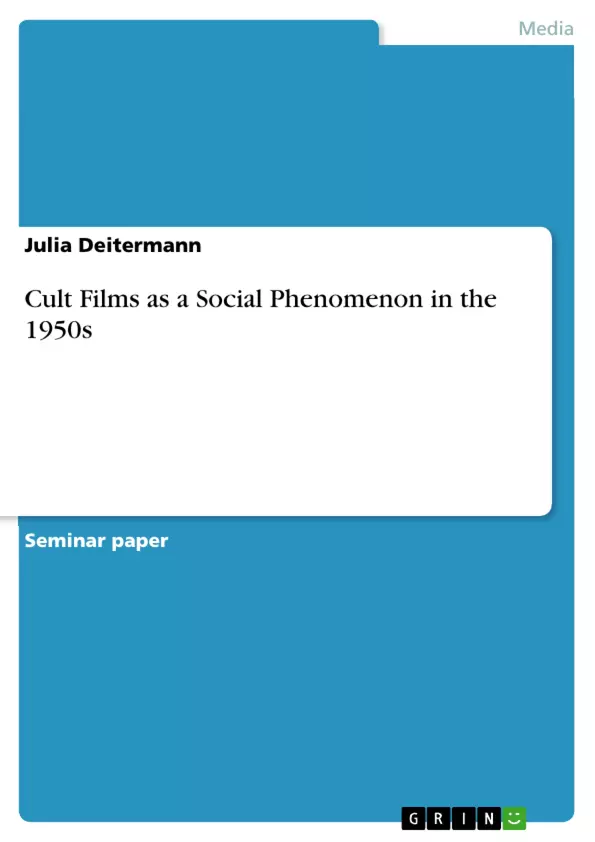The decade of the 1950s predominantly recalls ideas of conventionalism, conformity and gender boundaries. The home played an important role as an oasis of peace, retreat and security, thus the era is shaped by the widespread ideal of the suburban family. However, the notion of conformity and the idyll of the so-called ‘nuclear family’ served as points of attack for filmmakers as society’s indifferent and passive life was seen as the basis for their loss of individuality and free will. As a result, movies put emphasis on the fragility of society and the reversal of moral ideals, and filmmakers called for a more active participation in social and political life. Above all, people who lived in the idyll of peaceful suburb communities were afraid of an infiltration of their own individuality and of the dissolving of their integrity, a process which could in their opinion be provoked both physically, for example by the nuclear bomb, and mentally, that is by the spread of Communism. Consequently, the period following World War II was predominantly shaped by the influence of the Cold War which presented a seemingly peaceful situation but created great paranoia among people, such as the fear of the attack of hidden evil. The filmmakers’ way of dealing with the new situation was the introduction of science fiction horror movies which responded to the existing fear of an offensive by an external enemy. The enemy generally embodied the Communist threat and found its common representation in alien invasions. In the following, I will analyze the significance of cult films as a social phenomenon in the 1950s and thereby draw on films likeInvasion of the Body Snatchers, Invaders from Mars, The Incredible Shrinking Man,andGlen or Glenda?.In doing so, I will examine Cold War paranoia and the fear of the loss of integrity which dominated both people and film industry in the fifties. Due to the rising boom of the science fiction and horror genre, the 1950s can be referred to as the “decade of the monster movie”. The establishment of drive-in theaters increased people’s paranoia as outdoor cinemas reinforced the threat of an invasion by lacking the domestic security found indoors. Moreover, they responded to the demands of a new teenage culture of rebellion that praised their independence and lived out their adventures. One of the classic monster movies that was a huge success in drive-in theaters was Don Siegel‘sInvasion of the Body Snatchers,produced in 1956. [...]
Inhaltsverzeichnis (Table of Contents)
- Cult Films as a Social Phenomenon in the 1950s
- The Rise of the Science Fiction and Horror Genre
- Invasion of the Body Snatchers
- McCarthyism and the Fear of Conformity
- The Invisible Spread of an Unknown Malignancy
- Invaders from Mars
Zielsetzung und Themenschwerpunkte (Objectives and Key Themes)
This paper aims to analyze the significance of cult films as a social phenomenon in the 1950s, focusing on their reflection of Cold War anxieties and the fear of losing individual integrity. The paper draws upon films like Invasion of the Body Snatchers, Invaders from Mars, The Incredible Shrinking Man, and Glen or Glenda? to explore these anxieties.
- The impact of Cold War paranoia and the fear of an external enemy on 1950s society
- The use of science fiction horror films to address these anxieties
- The theme of alienation and the loss of individuality in the face of conformity
- The depiction of Communism as an invisible, insidious threat
- The connection between these themes and the rise of McCarthyism
Zusammenfassung der Kapitel (Chapter Summaries)
- The first chapter introduces the context of 1950s American society, characterized by conformity, the ideal of the suburban family, and the fear of communist infiltration. The chapter highlights the use of science fiction horror films to address these anxieties.
- The second chapter delves into the rise of the science fiction and horror genre in the 1950s, specifically highlighting the emergence of monster movies. This section discusses the impact of drive-in theaters on the genre and the reflection of teenage rebellion.
- The third chapter focuses on Don Siegel's Invasion of the Body Snatchers (1956) as a classic example of a cult film reflecting Cold War anxieties. The chapter analyzes the film's themes of alien dehumanization, the omnipresent threat of infiltration, and the loss of individuality through conformity.
- The fourth chapter examines the connection between McCarthyism and the anxieties depicted in these cult films. It discusses how the determined doctor fighting the threat in Invasion of the Body Snatchers could be seen as a parallel to McCarthy's political crusade.
- The fifth chapter focuses on the theme of an invisible, unknown malignancy, representing the fear of nuclear war and communist ideology. The chapter highlights the alien invasion as a metaphor for the fear of gradual, imperceptible brainwashing and the loss of human feelings and free will.
- The sixth chapter explores the film Invaders from Mars (1953), which shares similar themes with Invasion of the Body Snatchers but presents a different approach to the invasion. The chapter examines how the alien infiltration of the human body through the back of the head represents the fear of a slow, unconscious brainwashing by Communism.
Schlüsselwörter (Keywords)
The key concepts and themes explored in this paper include: Cold War paranoia, alien invasion, conformity, individuality, McCarthyism, science fiction horror, monster movies, drive-in theaters, the fear of the unknown, the loss of humanity, and the invisible threat.
- Citar trabajo
- Julia Deitermann (Autor), 2004, Cult Films as a Social Phenomenon in the 1950s, Múnich, GRIN Verlag, https://www.grin.com/document/61097



